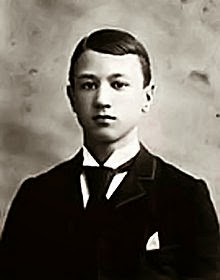 Borodin was a higly respected chemist, physician and teacher that was also an extremely gifted composer. Borodin was the illegitimate son of a Russian noble who had the child registered as the son of one of the nobleman's serfs. The nobleman saw to it that the child had a good general education as wel las music lessons. Borodin entered the Medical-Surgical Academy and upon graduation spent a year as an army surgeon, aftedr which he studied in Europe. He went back to St. Petersburg and became a professor of chemistry at the Imperial Medical-Surgical Academy. Borodin was an advocate for women's rights and was instrumental in establishing medical courses for women.
Borodin was a higly respected chemist, physician and teacher that was also an extremely gifted composer. Borodin was the illegitimate son of a Russian noble who had the child registered as the son of one of the nobleman's serfs. The nobleman saw to it that the child had a good general education as wel las music lessons. Borodin entered the Medical-Surgical Academy and upon graduation spent a year as an army surgeon, aftedr which he studied in Europe. He went back to St. Petersburg and became a professor of chemistry at the Imperial Medical-Surgical Academy. Borodin was an advocate for women's rights and was instrumental in establishing medical courses for women. The 2nd string quartet was written in 1881 and it is one of the few works that didn't take years to complete, as it was written while he was on a vacation. He dedicated the quartet to his wife on their 25th anniversary.
The quartet was popular during his life but it reached its peak of popularity in the early 1950's when some of the themes from the quartet (along with themes from other Borodin works) were used in the Broadway musical Kismet. The quartet is in 4 movements:
I. Allegro moderato - The quartet opens with a delicate theme in the key of D major. This theme segues into the second theme that is slightly more robust but maintains a lyrical quality. The development begins with the first theme heard in the cello. The recapitulation follows the same general plan of the exposition, but the second theme is first heard in E-flat major before it modulates to the home key of D major. Borodin manages to keep the lyrical quality throughout the first movement with just enough contrast to keep the interest of the listener.
II. Scherzo: Allegro - The scherzo begins in F major with a rapid first theme. The second theme appears and it was one of the themes used in the musical Kismet in a song called Baubles, Bangles and Beads. The movement is not in the traditional form of a scbherzo, but it is in sonata form. After the two themes are played at the beginning, a development section has both themes played in counterpoint, sometimes both are incorporated at the same time. The recapitulation has the themes repeated with the second theme modulating to F major. A short coda brings sthe movement to a quiet close.
III. Notturno: Andante - The cello plays the beautiful theme first, and then the violin takes it up. This theme was also used in the musical. The middle section the tempo quickens slightly into a dance. The opening theme appears again, this time with modulations to minor keys that bring a sense of drama to the duet between cello and violin. The two instruments respond with a contrapuntal duet of the theme. The theme is developed and repeated until the instruments reach a serene and quiet end to the movement.
IV. Finale: Andante, Vivace - The movement begins with an odd question and answer introduction that has the main theme of the movement presented in two sections, the question )played by the violins) interrupted by short sections, the answer (played by cello and viola). The pizaccato cello leads the beginning of the movement proper and the music increases in tempo. The movement is in sonata form, and the second theme maintains the speed of the first theme. The development section begins with the question (this time in the cello and viola) and answer (this time in the violins) as the exposition. The recapitulation begins with the question and answer, but this time all 4 instruments play it. Both themes are played and a short coda rounds off the quartet in the home key of D major.






